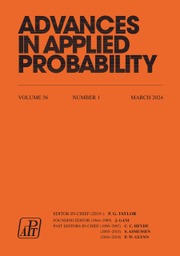Article contents
Distributions of random variables involved in discrete censored δ-shock models
Published online by Cambridge University Press: 19 May 2023
Abstract
Suppose that a system is affected by a sequence of random shocks that occur over certain time periods. In this paper we study the discrete censored  $\delta$-shock model,
$\delta$-shock model,  $\delta \ge 1$, for which the system fails whenever no shock occurs within a
$\delta \ge 1$, for which the system fails whenever no shock occurs within a  $\delta$-length time period from the last shock, by supposing that the interarrival times between consecutive shocks are described by a first-order Markov chain (as well as under the binomial shock process, i.e., when the interarrival times between successive shocks have a geometric distribution). Using the Markov chain embedding technique introduced by Chadjiconstantinidis et al. (Adv. Appl. Prob. 32, 2000), we study the joint and marginal distributions of the system’s lifetime, the number of shocks, and the number of periods in which no shocks occur, up to the failure of the system. The joint and marginal probability generating functions of these random variables are obtained, and several recursions and exact formulae are given for the evaluation of their probability mass functions and moments. It is shown that the system’s lifetime follows a Markov geometric distribution of order
$\delta$-length time period from the last shock, by supposing that the interarrival times between consecutive shocks are described by a first-order Markov chain (as well as under the binomial shock process, i.e., when the interarrival times between successive shocks have a geometric distribution). Using the Markov chain embedding technique introduced by Chadjiconstantinidis et al. (Adv. Appl. Prob. 32, 2000), we study the joint and marginal distributions of the system’s lifetime, the number of shocks, and the number of periods in which no shocks occur, up to the failure of the system. The joint and marginal probability generating functions of these random variables are obtained, and several recursions and exact formulae are given for the evaluation of their probability mass functions and moments. It is shown that the system’s lifetime follows a Markov geometric distribution of order  $\delta$ (a geometric distribution of order
$\delta$ (a geometric distribution of order  $\delta$ under the binomial setup) and also that it follows a matrix-geometric distribution. Some reliability properties are also given under the binomial shock process, by showing that a shift of the system’s lifetime random variable follows a compound geometric distribution. Finally, we introduce a new mixed discrete censored
$\delta$ under the binomial setup) and also that it follows a matrix-geometric distribution. Some reliability properties are also given under the binomial shock process, by showing that a shift of the system’s lifetime random variable follows a compound geometric distribution. Finally, we introduce a new mixed discrete censored  $\delta$-shock model, for which the system fails when no shock occurs within a
$\delta$-shock model, for which the system fails when no shock occurs within a  $\delta$-length time period from the last shock, or the magnitude of the shock is larger than a given critical threshold
$\delta$-length time period from the last shock, or the magnitude of the shock is larger than a given critical threshold  $\gamma >0$. Similarly, for this mixed model, we study the joint and marginal distributions of the system’s lifetime, the number of shocks, and the number of periods in which no shocks occur, up to the failure of the system, under the binomial shock process.
$\gamma >0$. Similarly, for this mixed model, we study the joint and marginal distributions of the system’s lifetime, the number of shocks, and the number of periods in which no shocks occur, up to the failure of the system, under the binomial shock process.
Keywords
MSC classification
Information
- Type
- Original Article
- Information
- Copyright
- © The Author(s), 2023. Published by Cambridge University Press on behalf of Applied Probability Trust
References
- 5
- Cited by


